Ministry of Statistics & Programme Implementation
Second Advance Estimates of National Income, 2022-23, Quarterly Estimates of Gross Domestic Product for the Third Quarter (October-December), 2022-23 and First Revised Estimates of National Income, Consumption Expenditure, Saving and Capital Formation, 2021-22
Posted On:
28 FEB 2023 5:30PM by PIB Delhi
The National Statistical Office (NSO), Ministry of Statistics and Programme Implementation (MoSPI) is releasing in this Press Note the Second Advance Estimates (SAE) of National Income, 2022-23, Quarterly Estimates of GDP for the quarter October-December (Q3), 2022-23 along with its expenditure components and following Revised Estimates of National Income, Consumption Expenditure, Saving and Capital Formation:
- First Revised Estimates (FRE) for the financial year 2021-22;
- Second Revised Estimates (SRE) for the financial year 2020-21; and
- Third Revised (TRE) or Final Estimates for the financial year 2019-20
These estimates are released both at Constant (2011-12) and Current Prices, in accordance with the release calendar of National Accounts.
- Real GDP or Gross Domestic Product (GDP) at Constant (2011-12) Prices in the year 2022-23 is estimated to attain a level of ₹ 159.71 lakh crore, as against the First Revised Estimate of GDP for the year 2021-22 of ₹ 149.26 lakh crore. The growth in GDP during 2022-23 is estimated at 7.0 percent as compared to that of 9.1 percent in 2021-22.
- Nominal GDP or GDP at Current Prices in the year 2022-23 is estimated to attain a level of
₹ 272.04 lakh crore, as against ₹ 234.71 lakh crore in 2021-22, showing a growth rate of 15.9 percent.
- GDP at Constant (2011-12) Prices in Q3 2022-23 is estimated at ₹40.19 lakh crore, as against ₹38.51 lakh crore in Q3 2021-22, showing a growth of 4.4 percent. GDP at Current Prices in Q3 2022-23 is estimated at ₹69.38 lakh crore, as against ₹62.39 lakh crore in Q3 2021-22, showing a growth of 11.2 percent.
- Detailed Notes on: (i) Second Advance Estimates (SAE) of National Income, 2022-23, Quarterly Estimates of GDP for the quarter October-December (Q3), 2022-23 along with its expenditure components; and (ii) abovementioned Revised Estimates for financial years 2021-22, 2020-21 and 2019-20 are given respectively in Part ‘A’ and Part ‘B’.
PART ‘A’
NOTE ON
SECOND ADVANCE ESTIMATES OF NATIONAL INCOME, 2022-23,
QUARTERLY ESTIMATES OF GROSS DOMESTIC PRODUCT FOR THE
THIRD QUARTER (OCT-DEC), 2022-23
In this part of the press note, the Second Advance Estimates (SAE) of National Income, 2022-23 as well as Quarterly Estimates of Gross Domestic Product (GDP) for the third quarter (October-December) of 2022-23 (Q3 2022-23) at both Constant (2011-12) and Current Prices are given.
2. Estimates of Gross/Net National Income and Per Capita Income along with Gross Value Added (GVA) at Basic Prices by kind of economic activity and the Expenditure Components of GDP for the year 2022-23 besides quarterly estimates and April-December Estimates for the years 2020-21, 2021-22 and 2022-23 at Constant (2011-12) and Current Prices, along with percent changes, are given in Statements 1A to 12A placed at the end of this part of the press note.
3. Real GDP or GDP at Constant (2011-12) Prices in the year 2022-23 is estimated at ₹159.71 lakh crore, as against the First Revised Estimates of GDP for the year 2021-22 of ₹149.26 lakh crore. The growth in real GDP during 2022-23 is estimated at 7.0 per cent as compared to 9.1 per cent in 2021-22.
4. Nominal GDP or GDP at Current Prices in the year 2022-23 is estimated at ₹272.04 lakh crore, as against the First Revised Estimates of GDP for the year 2021-22 of ₹234.71 lakh crore. The growth in nominal GDP during 2022-23 is estimated at 15.9 per cent as compared to 18.4 per cent in 2021-22.
5. GDP at Constant (2011-12) Prices in Q3 2022-23 is estimated at ₹40.19 lakh crore, as against ₹38.51 lakh crore in Q3 2021-22, showing a growth of 4.4 percent. GDP at Current Prices in Q3 2022-23 is estimated at ₹69.38 lakh crore, as against ₹62.39 lakh crore in Q3 2021-22, showing a growth of 11.2 percent.
6. The Advance Estimates of National Income are compiled using the benchmark-indicator method i.e. the estimates available for the previous year referred to as the benchmark year (2021-22 in this case) are extrapolated using the relevant indicators reflecting the performance of sectors. The First Advance Estimates (FAE) for 2022-23, based on very limited data and by using Provisional Estimates of 2021-22 (released on 31.05.2022) for the benchmark year, were earlier released on 06.01.2023.
7. For compilation of SAE 2022-23, the Provisional Estimates of 2021-22 used at the time of FAE have been replaced by First Revised Estimates (FRE) 2021-22 which have been compiled using industry-wise/institution-wise detailed information. Thus, variations in SAE from FAE is attributed to revision of benchmark estimates and additional data available on various indicators like CPI, IIP, Revised Estimates of fiscal data, financial results of listed companies etc. used for compiling the estimates for 2022-23. The quarterly estimates of previous years along with the first and second quarter estimates of 2022-23 released earlier have also undergone revision in accordance with the revision policy of National Accounts.
8. The sector-wise estimates have been compiled using indicators like (i) Index of Industrial Production (IIP), (ii) financial performance of Listed Companies in the Private Corporate sector available for Q1, Q2 and Q3 2022-23, (iii) Second Advance Estimates of Crop Production for 2022-23, (iv) Production targets for 2022-23 and production estimates of Major Livestock Products for Summer and Rainy seasons of 2022-23, (v) Fish Production, (vi) Production/ Consumption of Cement and Steel, (vii) Net Tonne Kilometres and Passenger Kilometres for Railways, (viii) Passenger and Cargo traffic handled by Civil Aviation, (ix) Cargo traffic handled at Major Sea Ports, (x) Sales of Commercial Vehicles, (xi) Bank Deposits & Credits, (xii) Accounts of Central & State Governments, etc., available for first 9/10 months of the financial year 2022-23. Percentage changes in the main indicators used in the estimation are given in the Annexure A.
9. The total tax revenue used for GDP compilation includes non-GST revenue and GST revenue. The Revised Estimates of tax revenue for 2022-23, as available in the Annual Financial Statement of the Central Government for 2023-24, latest available information on the websites of Controller General of Accounts (CGA) and Comptroller and Auditor General of India (CAG) have been used for estimating taxes on products at Current Prices. For compiling taxes on products at constant prices, volume extrapolation is done using volume growth of taxed goods and services. The total product subsidies were compiled using the latest information on major subsidies viz. Food, Urea, Petroleum and Nutrient based subsidy as available on CGA website and the expenditure incurred on subsidies by most States upto December, 2022 as available on CAG website along with the RE and BE provision for 2022-23 for Centre and States. Information available on Revenue expenditure, Interest payments, Subsidies etc. based on detailed analysis of budget documents of Centre and States for 2022-23 were also put to use for estimating Government Final Consumption Expenditure (GFCE).
10. Improved data coverage, actual performance of various indicators, actual tax collections and expenditure incurred on subsidies in the following months and revision in input data made by source agencies would have a bearing on subsequent revisions of these estimates. Estimates are, therefore, likely to undergo revisions for the aforesaid causes in due course, as per the release calendar. Users should take these into consideration while interpreting the figures.
11. The next release of quarterly GDP estimates for the quarter January-March, 2023 (Q4 2022-23) and Provisional Annual Estimates for the year 2022-23 will be on 31st May, 2023.
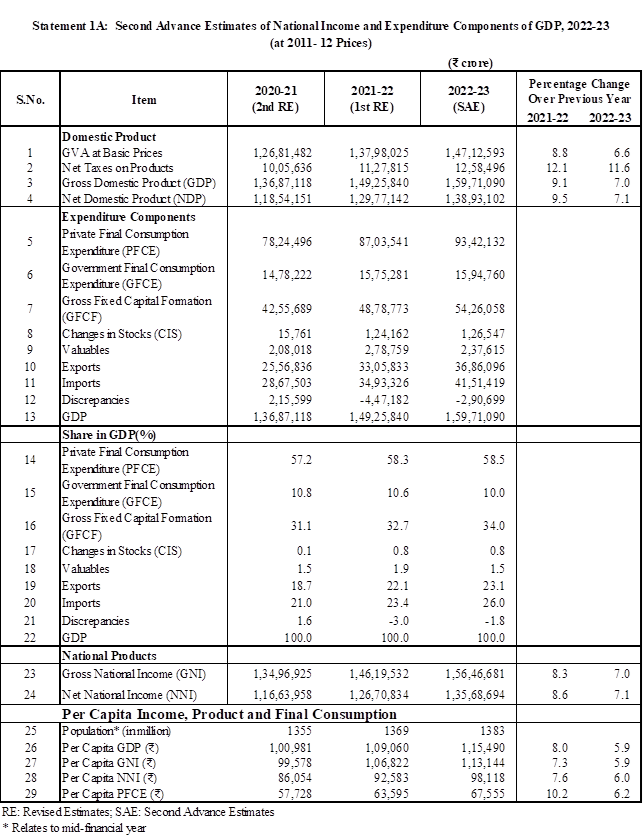
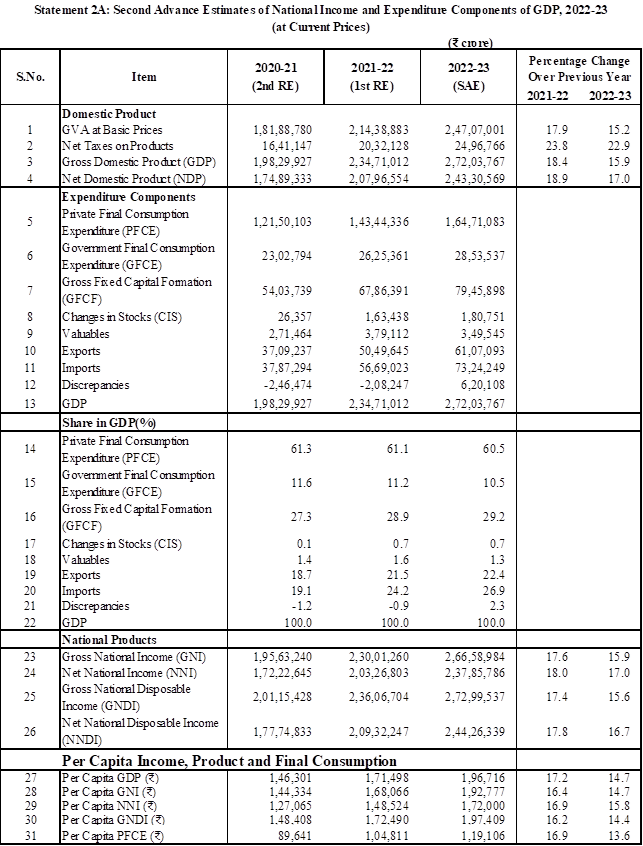
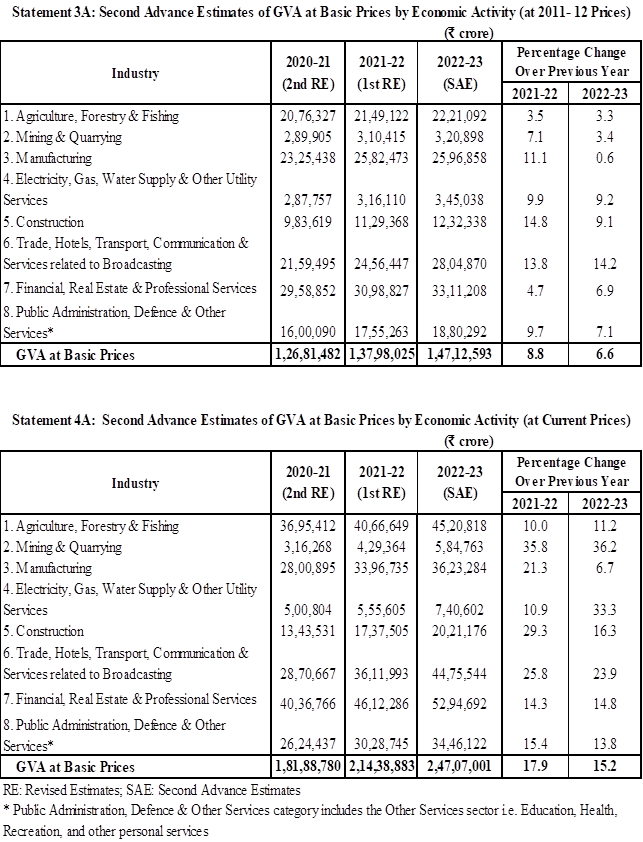
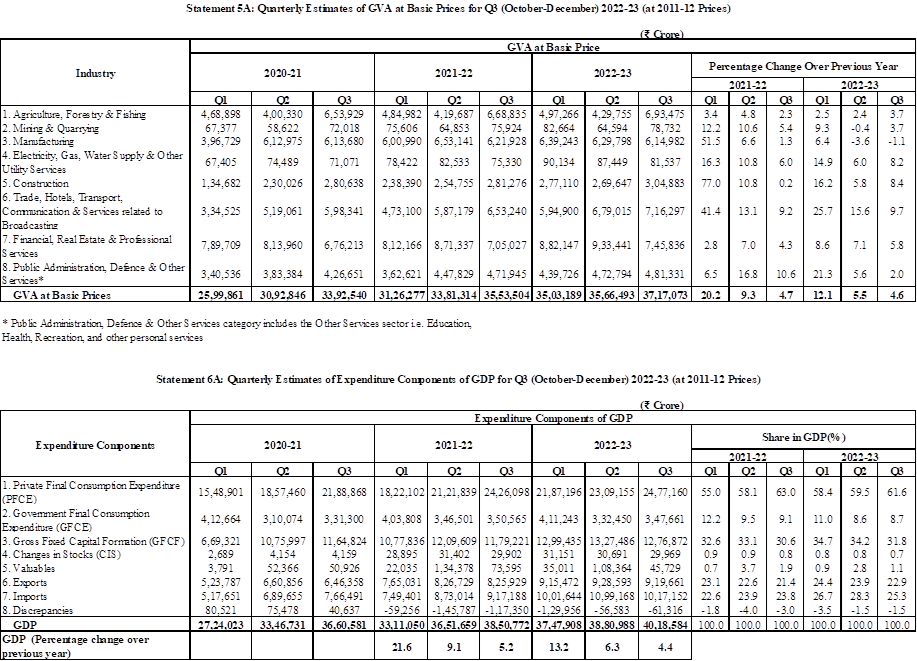
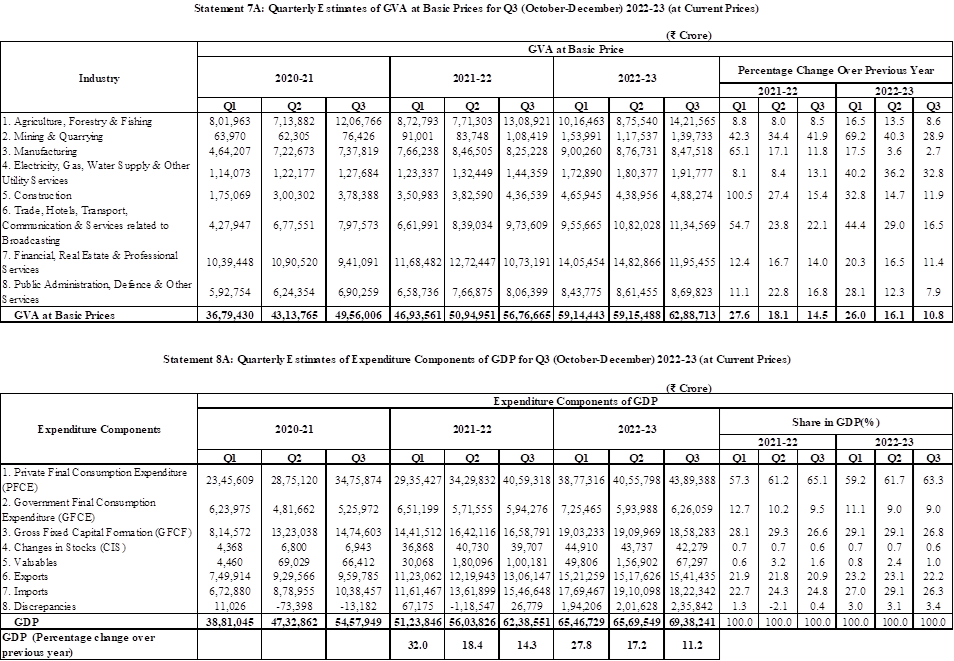
PART ‘B’
NOTE ON
FIRST REVISED ESTIMATES OF NATIONAL INCOME,
CONSUMPTION EXPENDITURE, SAVING AND CAPITAL FORMATION, 2021-22
In this part of the press note, First Revised Estimates of National Income, Consumption Expenditure, Saving and Capital Formation for the financial year 2021-22 along with Second Revised Estimates for the financial year 2020-21 and Third Revised Estimates for the financial year 2019-20 (with Base Year 2011-12) are given.
2. The First Revised Estimates for the year 2021-22 have been compiled using industry-wise/institution-wise detailed information instead of using the benchmark-indicator method employed at the time of release of Provisional Estimates on 31st May, 2022. The estimates of GDP and other aggregates for the years 2019-20 and 2020-21 have also undergone revisions on account of use of latest available datasets on agricultural production; industrial production (final results of ASI: 2019-20); government data as available in budget documents (replacing Revised Estimates with actuals for the year 2020-21); comprehensive data available from various source agencies like Ministry of Corporate Affairs (MCA), Reserve Bank of India (RBI), National Bank for Agriculture and Rural Development (NABARD) etc. and additional data from State/UT Directorates of Economics and Statistics (DES).
3. The salient features of the revised estimates at aggregate level are given in the paras that follow.
Gross Domestic Product
4. Nominal GDP or GDP at current prices for the year 2021-22 is estimated at ₹234.71 lakh crore as against ₹198.30 lakh crore for the year 2020-21, showing a growth of 18.4 per cent during 2021-22 as compared to contraction of 1.4 per cent during 2020-21.
5. Real GDP or GDP at constant (2011-12) prices for the years 2021-22 and 2020-21 stands at ₹149.26 lakh crore and ₹136.87 lakh crore, respectively, showing a growth of 9.1 per cent during 2021-22 as compared to contraction of 5.8 per cent during 2020-21.
GVA and its Industry-wise Analysis
6. At the aggregate level, nominal GVA at basic prices has increased by 17.9 per cent during 2021-22 against the decline of 1.0 per cent during 2020-21. Real GVA, i.e., GVA at constant (2011-12) basic prices, has increased by 8.8 per cent in 2021-22, as against contraction of 4.2 per cent in 2020-21.
7. The shares of broad sectors of the economy in overall GVA during 2011-12 to 2021-22 and the annual growth rates during this period are mentioned below:
|
Year
|
Sector-wise share in GVA at current prices (in %)
|
Sector-wise growth in GVA at constant (2011-12) prices (in %)
|
Aggregate GVA
(₹ in lakh crore)
|
|
Primary
|
Secondary
|
Tertiary
|
Primary
|
Secondary
|
Tertiary
|
All
|
Current
|
Constant
|
|
2011-12
|
21.7
|
29.3
|
49.0
|
|
|
|
|
81.1
|
81.1
|
|
2012-13
|
21.3
|
28.7
|
50.0
|
1.4
|
3.6
|
8.3
|
5.4
|
92.0
|
85.5
|
|
2013-14
|
21.4
|
27.9
|
50.6
|
4.8
|
4.2
|
7.7
|
6.1
|
103.6
|
90.6
|
|
2014-15
|
20.9
|
27.3
|
51.8
|
1.2
|
6.7
|
9.8
|
7.2
|
115.0
|
97.1
|
|
2015-16
|
20.1
|
27.6
|
52.3
|
2.1
|
9.5
|
9.4
|
8.0
|
125.7
|
104.9
|
|
2016-17
|
20.4
|
27.0
|
52.6
|
7.3
|
7.5
|
8.5
|
8.0
|
139.7
|
113.3
|
|
2017-18
|
20.4
|
27.0
|
52.5
|
4.5
|
7.1
|
6.3
|
6.2
|
155.1
|
120.3
|
|
2018-19
|
19.8
|
26.9
|
53.3
|
1.6
|
5.9
|
7.2
|
5.8
|
171.8
|
127.3
|
|
2019-20*
|
20.3
|
25.0
|
54.8
|
4.8
|
-1.3
|
6.4
|
3.9
|
183.8
|
132.4
|
|
2020-21#
|
22.1
|
25.5
|
52.4
|
2.4
|
-0.2
|
-8.2
|
-4.2
|
181.9
|
126.8
|
|
2021-22@
|
21.0
|
26.5
|
52.5
|
3.9
|
12.0
|
8.8
|
8.8
|
214.4
|
138.0
|
*: Third Revised Estimates; #: Second Revised Estimates; @: First Revised Estimates
8. The growth rates of Primary sector (comprising Agriculture, Forestry, Fishing and Mining & Quarrying), Secondary sector (comprising Manufacturing, Electricity, Gas, Water Supply & Other Utility Services, and Construction) and Tertiary sector (Services) have been estimated as 3.9 per cent, 12.0 per cent and 8.8 respectively in 2021-22 as against a growth of 2.4 per cent, -0.2 per cent and -8.2 per cent, respectively, in the previous year. The growth in real GVA during 2021-22 is on account of growth in ‘Mining and Quarrying’, ‘Manufacturing’, ‘Electricity, Gas, Water Supply & Other Utility Services’, ‘Construction’, ‘Trade, repair, Hotels and Restaurants’, ‘Transport, Storage and Communication & Services related to Broadcasting’ and ‘Other services’ as may be seen from Statement 4.2B. However, ‘Agriculture, Forestry and Fishing’, ‘Financial Services’, ‘Real Estate, Ownership of Dwelling & Professional Services’ and ‘Public Administration and Defence’ have witnessed modest growth during this period.
Net National Income
9. Nominal Net National Income (NNI) or NNI at current prices for the year 2021-22 stands at ₹203.27 lakh crore as against ₹172.23 lakh crore in 2020-21, showing a growth of 18.0 per cent during 2021-22 as against contraction of 3.0 per cent in the previous year.
Gross National Disposable Income
10. Gross National Disposable Income (GNDI) at current prices is estimated at ₹236.07 lakh crore for the year 2021-22, while the estimate for the year 2020-21 stands at ₹201.15 lakh crore, showing a growth of 17.4 per cent for year 2021-22 as against contraction of 1.6 per cent in the year 2020-21.
Saving
11. Gross Saving during 2021-22 is estimated at ₹70.77 lakh crore against ₹57.17 lakh crore during 2020-21. Share of Non-financial corporations, Financial corporations, General Government and Household sectors in Gross Savings during 2021-22 stands at 35.3%, 8.4%, (-) 8.9% and 65.3% respectively. Rate of Gross Saving to GNDI for 2021-22 is estimated at 30.0 per cent as against 28.4 per cent for 2020-21.
Capital Formation
12. Gross Capital Formation (GCF) at current prices is estimated at ₹73.62 lakh crore for the year 2021-22 as compared to ₹55.27 lakh crore during 2020-21. The rate of GCF to GDP is 31.4 per cent during 2021-22 as against 27.9 per cent in the 2020-21. The rates of capital formation in the years 2011-12 to 2019-20 and 2021-22 have been higher than the rate of saving because of positive net capital flow from RoW.
13. In terms of the share to the total GFCF (at current prices), the highest contributor is Non-Financial Corporations followed by Household sector, share of which stood at 44.1% and 40.5% respectively in 2021-22.
14. The rate of GCF to GDP at constant (2011-12) prices was 31.7 per cent in 2020-21 and 35.5 per cent in 2021-22.
Consumption Expenditure
15. Private Final Consumption Expenditure (PFCE) at current prices is estimated at ₹143.44 lakh crore for the year 2021-22 as against ₹121.50 lakh crore in 2020-21. In relation to GDP, the PFCE to GDP ratio at current prices during 2020-21 and 2021-22 are 61.3 per cent and 61.1 per cent respectively. At constant (2011-12) prices, the PFCE is estimated at ₹78.24 lakh crore and ₹87.04 lakh crore, respectively, for the years 2020-21 and 2021-22. The corresponding PFCE to GDP ratio for the years 2020-21 and 2021-22 are 57.2 per cent and 58.3 per cent respectively.
16. Government Final Consumption Expenditure (GFCE) at current prices is estimated at ₹26.25 lakh crore for the year 2021-22 as against ₹23.03 lakh crore during 2020-21. At constant (2011-12) prices the estimates of GFCE for the years 2020-21 and 2021-22 stand at ₹14.78 lakh crore and ₹15.75 lakh crore respectively.
Per Capita Estimates
17. Per Capita Income i.e. Per Capita Net National Income at current prices is estimated at ₹1,27,065 and ₹1,48,524 respectively for the years 2020-21 and 2021-22. Per Capita PFCE at current prices, for the years 2020-21 and 2021-22 is estimated at ₹89,641 and ₹104,811 respectively.
Summary of Revisions in the GDP Estimates
Revision in the estimates of the year 2021-22
18. The following statement gives the major reasons of variation between the Provisional Estimates (released on 31st May, 2022) and the First Revised Estimates of GVA for 2021-22.
|
Sector
|
GVA growth in 2021-22
(at 2011-12 Prices)
|
Major reasons for variation
|
|
Prov. Estimate (PE),
May 2022
|
First Revised Estimate (FRE),
Feb 2023
|
|
Primary[i]
|
4.1
|
3.9
|
GVA estimates of Agriculture, Forestry and Fishing sectors have undergone revision due to revision in production estimates of crop sector as per 4th Advance estimate of Ministry of Agriculture and Farmers welfare. Also, for horticulture sector, 3rd Advance estimates of production have been used. The revision in other industries in Primary Sector is due to the incorporation of latest revised data.
|
|
Secondary[ii]
|
10.2
|
12.0
|
Estimates of secondary sector have undergone upward revision due to availability of additional data in respect of companies post PE FY 2021-22 release and revision in input data by source agencies.
|
|
Tertiary[iii]
|
8.4
|
8.8
|
Estimates of tertiary sector have undergone upward revision due to availability of additional data in respect of companies post PE FY 2021-22 release and revision in input data by source agencies. Furthermore, the revision is due to the use of Revised Estimates (RE) from Union and State Governments’ budget documents and the information on Actual Expenditure of various Ministries/Departments of Union Government for 2021-22 has been used to the extent available on e-lekha.
|
|
Total GVA at Basic Prices
|
8.1
|
8.8
|
|
|
GDP
|
8.7
|
9.1
|
|
Reason(s) for revisions in the estimates of the years 2019-20 and 2020-21
19. The use of latest available data from various agencies has resulted in some changes in both the levels of GVA and growth estimates for the years 2019-20 and 2020-21.
Revisions in Major Aggregates
20. The level of revisions in the major aggregates at current and constant (2011-12) prices are given in the following table:
Major National Income Aggregates and their % Changes
(₹ in Lakh Crore)
|
S.No.
|
Item
|
2019-20
|
2020-21
|
|
2nd RE
|
3rd RE
|
% change
|
1st RE
|
2nd RE
|
% change
|
|
At current prices
|
|
1
|
GVA at basic prices
|
183.55
|
183.81
|
0.1
|
180.58
|
181.89
|
0.7
|
|
2
|
GDP
|
200.75
|
201.04
|
0.1
|
198.01
|
198.30
|
0.1
|
|
3
|
GNI
|
198.82
|
199.10
|
0.1
|
195.34
|
195.63
|
0.1
|
|
4
|
NNI
|
177.17
|
177.47
|
0.2
|
171.94
|
172.23
|
0.2
|
|
5
|
GNDI
|
204.22
|
204.51
|
0.1
|
200.86
|
201.15
|
0.1
|
|
At constant (2011-12) prices
|
|
1
|
GVA at basic prices
|
132.19
|
132.36
|
0.1
|
125.85
|
126.81
|
0.8
|
|
2
|
GDP
|
145.16
|
145.35
|
0.1
|
135.58
|
136.87
|
0.9
|
|
3
|
GNI
|
143.74
|
143.93
|
0.1
|
133.68
|
134.97
|
1.0
|
|
4
|
NNI
|
126.42
|
126.62
|
0.2
|
115.36
|
116.64
|
1.1
|
Major reasons for revisions in GVA/GDP estimates are as given below:
Year 2019-20
- Use of updated estimates of production and prices of some crops, livestock products, fish and forestry products from few States & DESs and latest CCS (2019-20) rates of by-products in crop sector.
- Use of final results of ASI: 2019-20 in place of combined growth of IIP and WPI.
- Use of latest reports of few NBFIs/ financial auxiliaries.
- Use of updated information received from state governments and local bodies.
Year 2020-21
- Use of updated production estimates (Final Estimates) of Foodgrains, Commercial and Horticulture crops from Ministry of Agriculture and Farmers’ Welfare in place of 4th Advance and 3rd Advance estimates, respectively.
- Use of updated estimates of production and prices of some crops, livestock products, fish and forestry products from a few states and DESs; and latest CCS (2019-20) rates of by-products in crop sector.
- Use of updated input rate received from IBM.
- Use of ASI: 2020-21 data and augmented data for non-financial private corporate sector.
- Use of ‘Actuals’ in place of ‘Revised Estimates’ of different items of expenditure and receipts in the Central & State government budgets.
- Use of updated information on Local Bodies & Autonomous Institutions.
- Use of latest annual reports of Public Sector Enterprises.
- Use of latest data received for Cooperative Banks, Postal Life Insurance (PLI) & Post Office Saving Bank (POSB), Non-Banking Financial Institutions (NBFIs), and Financial Auxiliaries.
Detailed statements
21. List of Statements released in part ‘B’ of the press note is given below. More details of the revised estimates, i.e., FRE 2021-22, SRE 2020-21 and TRE 2019-20 are available in Statements 1.1B to 9B placed at the end of this part of the press note.
- Statement 1.1B: Key Aggregates of National Accounts at Current Prices
- Statement 1.2B: Key Aggregates of National Accounts at Constant (2011-12) Prices
- Statement 2B: Per Capita Income, Product and Final Consumption
- Statement 3.1B: Output by Economic Activity and Capital Formation by Industry of
Use at Current Prices
- Statement 3.2B: Output by Economic Activity and Capital Formation by Industry of
Use at Constant (2011-12) Prices
- Statement 4.1B: Gross Value Added by Economic Activity at Current Basic Prices
- Statement 4.2B: Gross Value Added by Economic Activity at Constant (2011-12)
Basic Prices
- Statement 5B: Finances for Gross Capital Formation
- Statement 6.1B: Gross Capital Formation by Industry of Use at Current Prices
- Statement 6.2B: Gross Capital Formation by Industry of Use at Constant (2011-12)
Prices
- Statement 7.1B: Gross Fixed Capital Formation by Asset & Institutional Sector at
Current Prices
- Statement 7.2B: Gross Fixed Capital Formation by Asset & Institutional Sector at
Constant (2011-12) Prices
- Statement 8.1B: Private Final Consumption Expenditure at Current Prices
- Statement 8.2B: Private Final Consumption Expenditure at Constant (2011-12) Prices
- Statement 9B: Institutional Sectors – Key Economic Indicators at Current Prices
Annexure B
FORMULAE
- GVA at basic prices (Production Approach) = Output at basic price – Intermediate Consumption
- GVA at basic prices (Income Approach) = CE + OS/MI + CFC + Production taxes less Production subsidies(i)
- GDP = ∑ GVA at basic prices + Product taxes less Product subsidies(ii)
- NDP/NNI = GDP/GNI - CFC
- GNI = GDP + Net primary income from ROW (Receipts less payments)
- Primary Incomes = CE + Property and Entrepreneurial Income
- NNDI =NNI + other current transfers(iii) from ROW, net (Receipts less payments)
- GNDI = NNDI + CFC = GNI + other current transfers(iii) from ROW, net (Receipts less payments)
- Gross Capital Formation(iv) (Financing Side) = Gross Savings + Net Capital Inflow from ROW
- GCF (Expenditure Side) = GFCF + CIS + Valuables
- Gross Disposable Income of Govt. = GFCE + Gross Saving of General Government
- Gross Disposable Income (GDI) of Households = GNDI – GDI of Govt. – Gross Savings of All Corporations
REMARKS ON THE FORMULAE
- Production taxes or subsidies are paid or received with relation to production and are independent of the volume of actual production. Some examples are:
Production Taxes - Land Revenues, Stamps & Registration fees and Tax on profession
Production Subsidies - Subsidies to Railways, Subsidies to village and small industries.
- Product taxes or subsidies are paid or received on per unit of product. Some examples are:
Product Taxes- Excise duties, Sales tax, Service Tax and Import, Export duties
Product Subsidies- Food, Petroleum and fertilizer subsidies.
- Other Current Transfers refers to current transfers other than the primary incomes.
- Gross Capital Formation (GCF) at the current as well as the constant prices is estimated by two approaches: – (i) through flow of funds, derived as Gross Saving plus net capital flow from Rest of the World (RoW); and (ii) by the commodity flow approach, derived by the type of assets. The estimates of GCF through the flow of funds approach are treated as the firmer estimates. GCF by industry of use and by institutional sectors does not include ‘valuables’ and therefore, these estimates are lower than the estimates available from commodity flow approach.
******
Click here to see Press Note in PDF
DS/VJ
[i] Primary sector comprises agriculture, forestry, fishing and mining & quarrying activities.
[ii] Secondary sector comprises manufacturing; electricity, gas, water supply & other utility services and construction
[iii] Tertiary sector comprises all services.
(Release ID: 1903091)
Visitor Counter : 37113